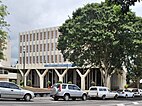| Sunshine Coast Queensland | |||||||||
|---|---|---|---|---|---|---|---|---|---|
 | |||||||||
| Coordinates | 26°39′15″S 153°05′36″E / 26.65417°S 153.09333°E | ||||||||
| Population | 398,840 (2021)[1][2] (9th) | ||||||||
| • Density | 244.24/km2 (632.57/sq mi) | ||||||||
| Area | 1,633 km2 (630.5 sq mi)[3] (2016 urban) | ||||||||
| Location | 100 km (62 mi) from Brisbane | ||||||||
| LGA(s) | |||||||||
| State electorate(s) | Buderim, Caloundra, Glass House, Kawana, Maroochydore, Nicklin, Noosa | ||||||||
| Federal division(s) | |||||||||
| |||||||||
The Sunshine Coast is a peri-urban region in South East Queensland, Australia. In 1967, it was defined as "the area contained in the [former] Shires of Landsborough, Maroochy and Noosa, but excluding Bribie Island".[4] Located 100 km (62 mi) north of the centre of Brisbane in South East Queensland, on the Coral Sea coastline, its urban area spans approximately 60 km (37 mi) of coastline and hinterland from Pelican Waters to Tewantin.
The area has several coastal hubs at Caloundra, Kawana Waters, Maroochydore and Noosa Heads. Nambour and Maleny have developed as primary commercial centres for the hinterland.
Since 2014, the Sunshine Coast district has been split into two local government areas, the Sunshine Coast Region and the Shire of Noosa, which administer the southern and northern parts of the Sunshine Coast respectively.
As of June 2021, with an estimated urban population of 398,840,[2] the Sunshine Coast is the fifth most populated area in Queensland and the 9th most populous in the country.[2] The population of the area has grown steadily at an average annual rate of 2.4% year-on-year over the five years to 2018.[2]
- ^ "Sunshine Coast". Australian Bureau of Statistics. Archived from the original on 29 June 2022. Retrieved 29 June 2022.
- ^ a b c d "Regional population". Australian Bureau of Statistics. 26 July 2022. Archived from the original on 30 March 2021. Retrieved 3 October 2022.
- ^ "2016 Census Quickstats: Sunshine Coast". ABS Census. Australian Bureau of Statistics. Archived from the original on 14 April 2018. Retrieved 14 April 2018.
- ^ "Sunshine Coast – district (entry 32861)". Queensland Place Names. Queensland Government. Retrieved 26 November 2017.






